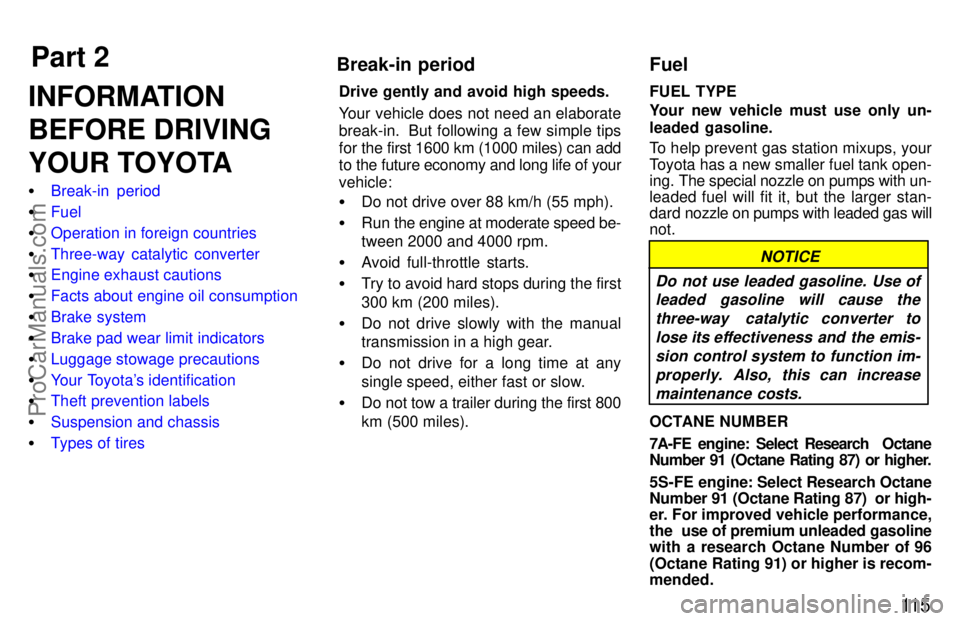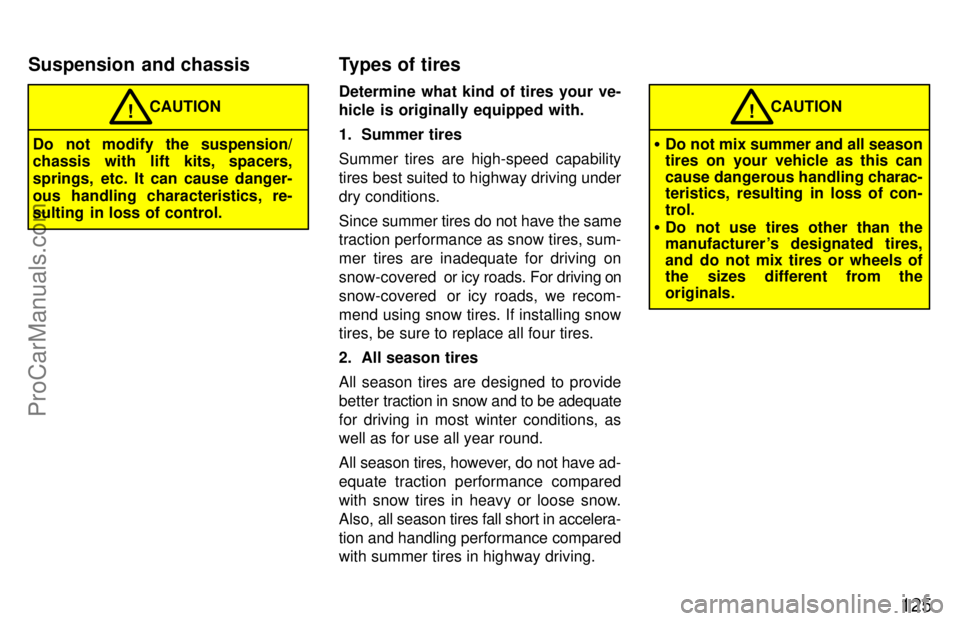Page 38 of 218

33
Do not perform any of the followingchanges without consulting your
Toyota dealer. Such changes caninterfere with proper operation ofthe SRS airbag system in somecases.
�Installation of electronic itemssuch as a mobile two-way radio,
cassette tape player or compactdisc player
�Modification of the suspension
system
�Modification of the front endstructure
�Attachment of a grille guard (bullbar, kangaroo bar, etc.), snow-
plow, winches or any other equip-ment to the front end
�Repairs made on or near the frontend structure, console, steeringcolumn, steering wheel or dash-board near the front passenger
airbag
NOTICE
This SRS airbag system has a service re-
minder indicator to inform the driver of op-
erating problems. If either of the following
conditions occurs, this indicates a mal-
function of the airbags. Contact your To-
yota dealer as soon as possible to service
the vehicle.
� The light does not come on when the
ignition key is turned to the ACCº or
ONº position, or remains on.
� The light comes on while driving.In the following cases, contact your Toyo-
ta dealer as soon as possible:
�The SRS airbags have been inflated.
� The front part of the vehicle (shaded in
the illustration) was involved in an ac-
cident not of the extent to cause the
SRS airbags to inflate
� The pad section of the steering wheel
or front passenger airbag cover
(shaded in the illustration) is scratched,
cracked, or otherwise damaged.
ProCarManuals.com
Page 121 of 218

Part 2Break-in periodFuel
11 5
INFORMATION
BEFORE DRIVING
YOUR TOYOTA
�Break-in period
� Fuel
� Operation in foreign countries
� Three-way catalytic converter
� Engine exhaust cautions
� Facts about engine oil consumption
� Brake system
� Brake pad wear limit indicators
� Luggage stowage precautions
� Your Toyota's identification
� Theft prevention labels
� Suspension and chassis
� Types of tires Drive gently and avoid high speeds.
Your vehicle does not need an elaborate
break-in. But following a few simple tips
for the first 1600 km (1000 miles) can add
to the future economy and long life of your
vehicle:
�
Do not drive over 88 km/h (55 mph).
� Run the engine at moderate speed be-
tween 2000 and 4000 rpm.
� Avoid full-throttle starts.
� Try to avoid hard stops during the first
300 km (200 miles).
� Do not drive slowly with the manual
transmission in a high gear.
� Do not drive for a long time at any
single speed, either fast or slow.
� Do not tow a trailer during the first 800
km (500 miles). FUEL TYPE
Your new vehicle must use only un-
leaded gasoline.
To help prevent gas station mixups, your
Toyota has a new smaller fuel tank open-
ing.
The special nozzle on pumps with un-
leaded fuel will fit it, but the larger stan-
dard nozzle on pumps with leaded gas will
not.
NOTICE
Do not use leaded gasoline. Use of leaded gasoline will cause the
three-way catalytic converter tolose its effectiveness and the emis-sion control system to function im-properly. Also, this can increasemaintenance costs.
OCTANE NUMBER
7A-FE engine: Select Research Octane
Number 91 (Octane Rating 87) or higher.
5S-FE engine: Select Research Octane
Number 91 (Octane Rating 87) or high-
er. For improved vehicle performance,
the use of premium unleaded gasoline
with a research Octane Number of 96
(Octane Rating 91) or higher is recom-
mended.
ProCarManuals.com
Page 131 of 218

125
CAUTION!
Do not modify the suspension/
chassis with lift kits, spacers,
springs, etc. It can cause danger-
ous handling characteristics, re-
sulting in loss of control.Determine what kind of tires your ve-
hicle is originally equipped with.
1. Summer tires
Summer tires are high-speed capability
tires best suited to highway driving under
dry conditions.
Since
summer tires do not have the same
traction performance as snow tires, sum-
mer tires are inadequate for driving on
snow-covered or icy roads. For driving on
snow-covered or icy roads, we recom-
mend using snow tires. If installing snow
tires, be sure to replace all four tires.
2. All season tires
All season tires are designed to provide
better traction in snow and to be adequate
for driving in most winter conditions, as
well as for use all year round.
All season tires, however, do not have ad-
equate traction performance compared
with snow tires in heavy or loose snow.
Also, all season tires fall short in accelera-
tion and handling performance compared
with summer tires in highway driving.
CAUTION!
� Do not mix summer and all season
tires on your vehicle as this can
cause dangerous handling charac-
teristics, resulting in loss of con-
trol.
� Do not use tires other than the
manufacturer 's designated tires,
and do not mix tires or wheels of
the sizes different from the
originals.
Suspension and chassis Types of tires
ProCarManuals.com
Page 172 of 218

166
Washer fluid
Make sure there is sufficient fluid in the
tank. See Chapter 7-3 for additional infor-
mation.
Engine coolant level
Make sure the coolant level is between
the FULLº and LOWº lines on the see-
through reservoir when the engine is cold.
See Chapter 7-2 for additional informa-
tion.
Battery electrolyte level
Make sure the electrolyte level of all bat-
tery cells is between upper and lower level
lines on the case. Add only distilled water
when replenishing. See Chapter 7-3 for
additional information.
Brake fluid level
Make sure the brake fluid level is correct.
See Chapter 7-2 for additional informa-
tion.
Engine oil level
Check the l evel on the dipstick with the en-
gine turned off and the vehicle parked on
a level spot. See Chapter 7-2 for addition-
al information. Power steering fluid level
Check the level on the dipstick (vehicles
with 7A-FE engine), or check the level
through the reservoir (vehicles with 5S-
FE engine). The level should be in the
HOTº or COLDº range depending on the
fluid temperature. See Chapter 7-2 for
additional information.
Exhaust system
If you notice any change in the sound of
the exhaust or smell exhaust fumes, have
the cause located and corrected immedi-
ately. (See engine exhaust cautions in
Part 2.)
Be on the alert for changes in perfor-
mance, sounds, and visual tip-offs
that in-
dicate service is needed. Some important
clues are as follows:
� Engine missing, stumbling, or pinging
� Appreciable loss of power
� Strange engine noises
� A leak under the vehicle (however, wa-
ter dripping from the air conditioning
after use is normal.)
� Change in exhaust sound (This may
indicate a dangerous carbon monox-
ide leak. Drive with the windows open
and have the exhaust system checked
immediately.)
� Flat-looking tire; excessive tire squeal
when cornering; uneven tire wear
� Vehicle pulls to one side when driving
straight on a level road
� Strange noises related to suspension
movement
� Loss of brake effectiveness; spongy
feeling brake or clutch pedal; pedal al-
most touches floor; vehicle pulls to one
side when braking
� Engine coolant temperature continual-
ly higher than normal
Does your vehicle need
repairing?
ProCarManuals.com